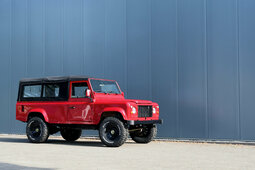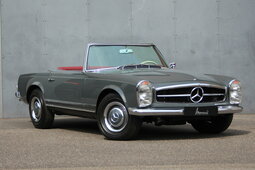Explore iconic American automobiles like the Dodge Charger, Challenger, Chevrolet Camaro, Ford Mustang, along with the now-retired Chevrolet SS and Dodge Viper. These vehicles represent the zenith of the American car industry's glory days, a time when manufacturers prioritized power and performance over environmental concerns, equipping their vehicles with massive, thunderous engines.
The Ford Mustang stands as a testament to American culture, yet in Europe, it's seen as distinctly unique, unmatched in its appeal. European automobiles typically embody seriousness, style, and subtlety, reflecting a preference for understated elegance and sophistication. However, the Mustang evokes the spirit of 1970s rock music, inspiring a desire to engage in a thrilling burnout. Its resemblance to a classic toy car is precisely what makes it so endearing and charismatic.
Timeless Design
Ford openly acknowledges the collaboration with its European division in crafting the upcoming generation of the Mustang, aiming to captivate both American and European audiences. While its silhouette nods to its predecessors, beneath the recognizable exterior lies a groundbreaking design overhaul.
The engineering team introduced modifications to the front and rear struts' placement, alongside a more aerodynamic, sloped roofline. The car's widened stance is cleverly masked by its voluptuous "hips," which house a rear track expanded by 7 cm. Additionally, this iteration of the Mustang moves away from the dated spring system, a staple of the '70s yet unremarked upon by American consumers. To align more closely with European preferences, the vehicle adopts a Multi-Link rear suspension setup, enhancing its handling and ability to execute precise turns.
In Europe, the Ford Mustang is available with either a 2.3-litre, turbocharged four-cylinder engine, also seen in the Ford Focus RS, or a 5.0-litre, V8 naturally aspirated powerhouse. Options for transmission include a 6-speed manual or a 6-speed automatic gearbox.
Theoretically, the smaller Ecoboost engine is designed to offer the Mustang dynamic and efficient performance. According to the manufacturer, this version can accelerate from 0 to 100 km/h in approximately 6 seconds while maintaining a fuel consumption rate of about 8 litres per 100 km. However, we had the pleasure of experiencing the robust 8-cylinder engine firsthand (and what a thrill it was). Interestingly, in Europe, it's the 4-cylinder model that often becomes the choice over the V8, likely a nod to the stringent regulations and environmental considerations imposed by the European Union.
It's immediately clear that the Mustang is far from compact, both when you're standing next to it and once you're seated inside. At a glance, the Mustang seems designed to comfortably fit only two adults. This perception holds partially true, as the back seats are more accommodating for children, small adults, or luggage rather than individuals over 1.80 meters in height. Nonetheless, Ford's engineers deserve praise for crafting exceptionally comfortable and spacious rear seats, a stark contrast to the less accommodating alternatives typically found in vehicles of this category.
In the front, occupants are treated to ample space. The seats are wide and offer the kind of comfort expected from a car imported to Europe from the United States. From the driver's seat, the abundance of buttons on the steering wheel might seem overwhelming, and navigating the control system can be a bit intricate. Initial attempts to master these controls may prove challenging.
The infotainment system merits a special mention, being significantly more advanced than what's available in the Ford Focus RS. The display is positioned nearly level with the gear lever, allowing those with longer fingers to seamlessly toggle through functions without removing their hand from the gear lever.
Driving Properties
What should you expect from a Ford Mustang as you approach a turn? If you anticipate steering precision that intuitively follows your every move, you might find yourself let down. The Ford Mustang doesn’t operate on such terms, and frankly, that’s part of its charm. Driving this behemoth offers a distinct experience altogether.
Maintaining control and not overstepping its boundaries, the Mustang’s handling somewhat echoes that of sporty hatchbacks from the previous decade. Not perfect, but thoroughly enjoyable and brimming with character. This is the essence of the Ford Mustang. It’s not a machine built for the racetrack finesse but rather for a more spirited, engaging drive. Allowing the car some freedom, especially letting the rear end playfully guide some of your maneuvers, adds to the thrill. Yet, there’s an alternative for those seeking a more subdued approach: a gentle tap on the brakes before entering a turn can transform the Mustang, making it behave like a tamed beast.
The potent 5-litre, V8 engine is a defining feature of the Ford Mustang, often overshadowing other aspects with its sheer force. Every press of the accelerator guarantees a joyous and somewhat goofy grin on the driver's face, thanks to the 421 bhp and 524 Nm of torque. Our test model came equipped with an automatic transmission. While not an impeccable match, this 6-speed gearbox efficiently manages gear shifts, eagerly dropping to lower gears when needed.
Opting to let the gearbox operate independently proves it's no less capable than its European rivals. Gear changes are swift, devoid of any unnecessary noise, and most critically, smooth. Driving at a steady pace allows the symphonic shifts of the exhaust system to serenade the cabin, enhancing the driving experience further.
Revisiting the engine, it sometimes presents itself as a formidable force, akin to a massive brick propelling the car forward. With its naturally aspirated design, it responds instantly to the accelerator, surging ahead with vigor. How quickly? According to the manufacturer, this Mustang variant dashes from 0 to 100 km/h in 4.7 seconds, topping out at a maximum speed of 250 km/h. Impressive, indeed. Yet, what truly astonishes is the engine's performance across the entire rev range, maintaining a vigorous pace. It's as if the engine inhales deeply before unleashing a monumental burst of power. Reaching the 6500 rpm ceiling only means the exhilarating cycle of the 8-cylinder spectacle is set to repeat.
Verdict
One might view this car with either disdain or awe; there seems to be no middle ground. The Ford Mustang has consistently been a vehicle that stirs strong feelings. Earlier iterations were brimming with charisma, yet they fell short of European expectations. However, the debut of the 6th generation marks a significant shift. The Ford Mustang still shines with the allure and distinctiveness of American automobiles, yet it now possesses qualities that appeal to the European sensibility - a blend of refinement and composure perfect for the chill of a Monday morning.
The Mustang may not be flawless, harboring some frustrating shortcomings, yet these diminish in significance when considering the vehicle's performance and the price tag attached. To acquire a European model with comparable power, you'd likely need to spend almost double. Would the experience be twice as satisfying? Certainly not.
A glimpse of the new Ford Mustang
FIRST LOOK: 2024 Seventh-Generation Ford Mustang | Top Gear
---
Begin your quest for the perfect vehicle by exploring our Car Categories. Or, immerse yourself in our Classic Passion Shop for a selection of intriguing products from our partners, ideal for collectors eager to augment their assortment!





















